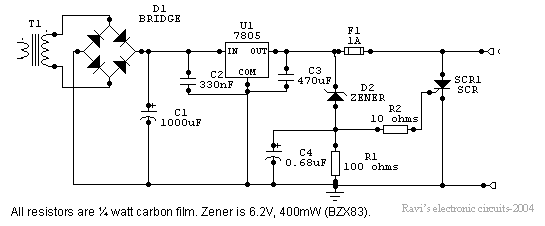Power Supply Overvoltage Protection
A circuit on a power supply designed to protect the connected equipment from receiving too much voltage if the supply should malfunction. The condition known as runaway voltage or over voltage (overvoltage) may occur causing the voltage level to exceed what the connected device can tolerate.
The typical power supply a control voltage is fed into a series regulating device such as a transistor known as a voltage regulator. Typically the input voltage to this may be well in excess of the output voltage. If the series regulator transistor in the power supply fails in a mode where it becomes a short circuit, the pre-regulated smoothed voltage level will be applied to the circuit being powered.

Basic Crowbar Protection Circuit
Crowbar
Many bench top power supplies have a crowbar circuit to protect the connected equipment. The two commonly used components for the crowbar device are Silicon Controlled Rectifier (SCR) and the MOSFET. A crowbar circuit is usually placed across the power supply's output terminals, to protect the load against any overvoltage.
silicon controlled rectifier
An SCR overvoltage crowbar circuit is an over voltage crowbar protection circuit using a silicon controlled rectifier or SCR. The SCR over voltage crowbar or protection circuit is connected between the output of the power supply and ground. The Zener diode voltage is chosen to be slightly above that of the output rail. Typically a 5 volt rail may run with a 6.2 volt Zener diode. When the Zener diode voltage is reached, current will flow through the Zener and trigger the silicon controlled rectifier or thyristor. This will then provide a short circuit to ground, thereby protecting the circuitry that is being supplied form any damage and also blowing the fuse that will then remove the voltage from the series regulator.
Clamp
A clamper is an electronic circuit that fixes either the positive or the negative peak excursions of a signal to a defined value by shifting its DC value. The clamper does not restrict the peak-to-peak excursion of the signal, it moves the whole signal up or down so as to place the peaks at the reference level. A diode clamp conducts electric current in only one direction and prevents the signal exceeding the reference value; and a capacitor which provides a DC offset from the stored charge. The capacitor forms a time constant with the resistor load which determines the range of frequencies over which the clamper will be effective.